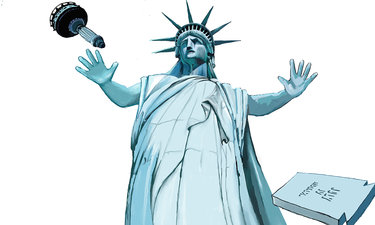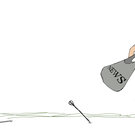Who will carry Liberty’s torch?
Once to every man and nation comes the moment to decide,
In the strife of Truth with Falsehood, for the good or evil side.
— “The Present Crisis” by James Russell Lowell
Do you want to see what diversity looks like?
Look at our photo gallery to take in Guilderland High School’s Cultural Fair, as photographed by Michael Koff.
See the delight on children’s faces as a student wearing a Japanese kimono shows kids the wonder of origami. See the swirl of shimmering red skirts as Indian dancers gesture with grace.
Look at little boys sampling Milkita candy from Indonesia as two Asian students prepare a traditional chicken dish. A sign at their table explains the milk-based, calcium-infused candy comes in vanilla, banana, strawberry, honeydew, and chocolate flavors.
Kids crowd around a table displaying a model of the Eiffel Tower as two students serve them a French breakfast of crêpes, made from unleavened batter. A third-grad girl watches intently as a high school student artfully applies a henna tattoo to her arm.
The audience is wrapt as a Chinese man dances with a dragon, its fiery orange tale swirling over his head, and as a woman performs a fan dance, somehow turning her two hot pink fans into a single bird or butterfly.
Later, a little girl picks up a dragon puppet herself and starts her own solo dance.
A Native American, with feathered headdress, performs as do a bagpiper and a string ensemble. Students and their families staff tables featuring cultures from Belize, Norway, Scotland, Israel, Poland, Trinidad and Tobago — and more. Dolls are displayed and so are pictures of poets and athletes.
Each is sharing their pride in who they are and where they come from.
The overarching feeling is one of celebration. Together, these students form a community. That community is stronger and richer because of its many diverse parts.
All of us could learn a lesson from this celebration.
Our nation is losing its way.
With two important exceptions — the Native Americans who lived on this land before Europeans arrived and the African Americans who were wrested from their homelands and brought here as slaves — the rest of us, or our ancestors, came to America willingly from other places and cultures.
We are a nation of immigrants, and that has long been our strength. Emma Lazarus wrote a poem, “The New Colossus,” describing our Statue of Liberty not like the brazen, conquering giant of Greek fame but, rather, as “a mighty woman with a torch … and her name Mother of Exiles.”
She cries with silent lips, “Give me your tired, your poor,/ Your huddled masses yearning to breathe free,/ The wretched refuse of your teeming shore. Send these, the homeless, tempest-tost to me, I lift my lamp beside the golden door!”
We are no longer a welcoming nation. We have become hateful not just to new immigrants but to many among us who have long been United States citizens but are not wealthy, white, male Christians.
Our president, Donald Trump, has fanned the flames of hatred and initiated many actions that meekly have been followed.
The Trump administration has moved to classify thousands of living immigrants — people who came to the United States legally — as dead, and cancel their Social Security numbers. This unprecedented move will make it hard for them to get jobs, use banks, file for benefits, or enroll their children in schools.
“If they can do it to one group they can do it to anyone — in error or in malice,” Kathleen Romig, director of Social Security and disability policy at the Center of Budget and Policy Priorities, posted on BlueSky.
“The police state is here, now,” former Social Security Administrator Martin O’Malley told The Associated Press.
Also this month, the Trump administration threatened to withhold funds from schools that have programs promoting diversity, equity, and inclusion — like Guilderland.
The Trump administration is dismantling the department of education, claiming that education is best handled by states yet at the same time is requiring state education officials to verify that they have eliminated all DEI programs the administration deems unlawful.
Put simply: This defies logic.
You can’t say that education is up to the states while simultaneously demanding that states do your bidding. And yet, here we are.
We again commend New York state for its stance against this perfidy. We’ve been horrified as Ivy League schools have acquiesced to demands from the Trump administration. The schools want to keep their federal funds so they have allowed the federal government to trounce on free-speech rights and dictate even curriculum.
If the Trump administration were truly against antisemitism, it wouldn’t forbid DEI initiatives and programs.
Companies from prominent law firms to Gannett, America’s largest newspaper chain, have fallen in line, ending DEI initiatives.
In its DEI purge, the federal government has removed historic accomplishments of people who are not white men from websites ranging from the Pentagon to the Park Service. None of us should accept the purging of our history.
Men and women of different races, religions, and cultures have all made important contributions to the United States. We erase that history at our own peril.
Government should not have the power to declare living people as dead nor to make important and accurate history disappear.
At last week’s rally at the University at Albany, protesting federal cuts to research, health care, and higher education, Fred Kowal, United University Professors president, said, “We are trying to save science. We’re trying to save the principle that the search for knowledge and wisdom is vital to the future of the human race. But, beyond that, we’re trying to save democracy.”
We’re grateful that our state’s education department has not caved. The department’s counsel and deputy commissioner, Daniel Morton-Bentley, wrote to the federal education department that state officials do not believe the federal department has the authority to make such demands.
“We understand that the current administration seeks to censor anything it deems ‘diversity, equity & inclusion,’” he wrote. “But there are no federal or State laws prohibiting the principles of DEI.”
We’re also grateful that the Guilderland schools are staying the course. Superintendent Marie Wiles told us in February that the threat of losing federal funds will not change the district’s approach to serving all students.
Guilderland currently receives about $1.9 million from the federal government with a $125 million budget this year.
“We are not going to in any way change our course in the work we do serving our students ….,” said Wiles. “It’s not that we’re doing diversity. We are diversity.”
That was made abundantly clear at the high school’s April 11 cultural fair.
The Guilderland school district has students who speak over 60 different languages in their homes. It’s a marvelously diverse community where students can gain an understanding of and respect for different cultures.
At the April 8 school board meeting, Parth Sarecha, a junior who gives the board monthly student updates, described the cultural fair as “representing different countries and cultures all throughout the world.”
Sarecha himself is of Indian heritage and earlier this year successfully petitioned the board to have Diwali, a Hindu holiday, recognized as a school holiday.
At that time, Sarecha told the board he was proud that Guilderland was a pioneer in diversity, equity, and inclusion.
On April 8, he told the board of the cultural fair, “I’m very excited to see everything that happens that day.”
Wiles shared with the school board something her son, Ben, a Guilderland High School senior, had said to her. He told her that the day of the Cultural Fair was his favorite of the entire school year.
She was thinking the day-long fair meant he’d get out of class.
“He surprised me once again when he said, ‘No. At the end of that school day, you can really feel like this is a community in this building.’”
Wouldn’t it be great if we could feel that as a nation? Not despite our differences — our varied religions, races, and cultures — but because of them, we are a community to be celebrated.


